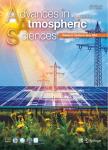The Effect of Typhoon-Induced SST Cooling on Typhoon Intensity: The Case of Typhoon Chanchu (2006)
The Effect of Typhoon-Induced SST Cooling on Typhoon Intensity: The Case of Typhoon Chanchu (2006)作者机构:Institute of Meteorology PLA University of Science and Technology Guangzhou Institute of Tropical and Marine Meteorology China Meteorological Administration Key Laboratory of Tropical Marine Environmental Dynamics South China Sea Institute of Oceanology Chinese Academy of Sciences
出 版 物:《Advances in Atmospheric Sciences》 (大气科学进展(英文版))
年 卷 期:2008年第25卷第6期
页 面:1062-1072页
核心收录:
学科分类:07[理学] 070601[理学-气象学] 0706[理学-大气科学]
基 金:the National Natural Science Foundation of China (Grant No. 40675065) National Key Basic Re- search Development Program (Grant Nos. 2007CB411805 and 2006CB403600)
主 题:coupled model air-sea interaction typhoon intensity SST cooling
摘 要:In order to investigate air-sea interactions during the life cycle of typhoons and the quantificational effects of typhoon-induced SST cooling on typhoon intensity, a mesoscale coupled air-sea model is developed based on the non-hydrostatic mesoscale model MM5 and the regional ocean model POM, which is used to simulate the life cycle of Typhoon Chanchu (2006) from a tropical depression to a typhoon followed by a steady weakening. The results show that improved intensity prediction is achieved after considering typhoon-induced SST cooling; the trend of the typhoon intensity change simulated by the coupled model is consistent with observations. The weakening stage of Typhoon Chanchu from 1200 UTC 15 May to 1800 UTC 16 May can be well reproduced, and it is the typhoon-induced SST cooling that makes Chanchu weaken during this period. Analysis reveals that the typhoon-induced SST cooling reduces the sensible and latent heat fluxes from the ocean to the typhoon's vortex, especially in the inner-core region. In this study, the average total heat flux in the inner-core region of the typhoon decrease by 57.2%, whereas typhoon intensity weakens by 46%. It is shown that incorporation of the typhoon-induced cooling, with an average value of 2.17℃, causes a 46-hPa weakening of the typhoon, which is about 20 hPa per 1℃ change in SST.



